|
|
 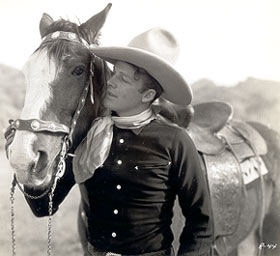
Ratings: Zero to 4 Stars.
 “BATTLING WITH BUFFALO BILL” (‘31 Universal serial) 12 chapters of endless Indian raids, attacks, fights, ambushes, skirmishes and massacres (a lot of it silent stock footage) becomes a bit ho-hum after several chapters. Tom Tyler is okay as Buffalo Bill and it’s nice to see Rex Bell as second lead but Francis Ford (John Ford’s brother) is ineffectual as lead heavy. “BATTLING WITH BUFFALO BILL” (‘31 Universal serial) 12 chapters of endless Indian raids, attacks, fights, ambushes, skirmishes and massacres (a lot of it silent stock footage) becomes a bit ho-hum after several chapters. Tom Tyler is okay as Buffalo Bill and it’s nice to see Rex Bell as second lead but Francis Ford (John Ford’s brother) is ineffectual as lead heavy.
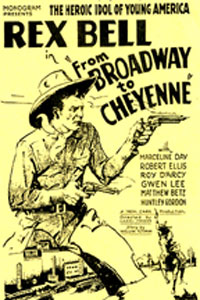  “BROADWAY TO CHEYENNE” (‘32 Monogram) After being shot in a nightclub gangland war, New York copper Rex Bell returns home to Wyoming for a rest, only to find his old nemesis (Robert Ellis) trying to pull the old protective association muscle out west. George Hayes, with a walrus mustache, is Rex’s old pal. One striking scene has the protective association gangsters mow down a bunch of innocent cattle with a machine gun! This was the first of the Bells that set up the novel precedent for his films that would start in the East and wind up out West. Some references list this title as “From Broadway to Cheyenne”, but the on screen title is simply “Broadway to Cheyenne”. “BROADWAY TO CHEYENNE” (‘32 Monogram) After being shot in a nightclub gangland war, New York copper Rex Bell returns home to Wyoming for a rest, only to find his old nemesis (Robert Ellis) trying to pull the old protective association muscle out west. George Hayes, with a walrus mustache, is Rex’s old pal. One striking scene has the protective association gangsters mow down a bunch of innocent cattle with a machine gun! This was the first of the Bells that set up the novel precedent for his films that would start in the East and wind up out West. Some references list this title as “From Broadway to Cheyenne”, but the on screen title is simply “Broadway to Cheyenne”.
“MAN FROM ARIZONA” (‘32 Monogram) Unfortunately, Bell’s second Trem Carr produced western is a lost film.
 “LUCKY LARRIGAN” (‘32 Monogram) Spoiled New York playboy Rex Bell tries to impress and marry Helen Foster, the daughter of his father’s business partner (John Elliott). Bell’s dad is a business partner in Elliott’s western cattle ranch which is suffering losses from rustlers, the foreman of the ranch Stanley Blystone and his henchman George Chesebro. Another of Bell’s East-goes-West westerns which is fine, except midway when Bell is disguised as a Mexican bandito to fool Helen—a cute idea perhaps carried to extremes. “LUCKY LARRIGAN” (‘32 Monogram) Spoiled New York playboy Rex Bell tries to impress and marry Helen Foster, the daughter of his father’s business partner (John Elliott). Bell’s dad is a business partner in Elliott’s western cattle ranch which is suffering losses from rustlers, the foreman of the ranch Stanley Blystone and his henchman George Chesebro. Another of Bell’s East-goes-West westerns which is fine, except midway when Bell is disguised as a Mexican bandito to fool Helen—a cute idea perhaps carried to extremes.
 “DIAMOND TRAIL” (‘32 Monogram) Another version of the standard formula of starting in the East and carrying the action West as brash newspaper reporter Bell sidles up to gangster Lloyd Whitlock who hijacks stolen diamonds from other racketeers then ships them west to Bud Osborne who is sneakily double-crossing Whitlock. Directed with more flair than usual by Harry Fraser with a better than average script, “Diamond Trail” provides some other form of menace than the usual stage robbers and rustlers. “DIAMOND TRAIL” (‘32 Monogram) Another version of the standard formula of starting in the East and carrying the action West as brash newspaper reporter Bell sidles up to gangster Lloyd Whitlock who hijacks stolen diamonds from other racketeers then ships them west to Bud Osborne who is sneakily double-crossing Whitlock. Directed with more flair than usual by Harry Fraser with a better than average script, “Diamond Trail” provides some other form of menace than the usual stage robbers and rustlers.
 “CRASHIN’ BROADWAY” (‘33 Monogram) Rex—“The Clever Cowboy, A Breath Of The West”—as he’s billed while a vaudeville rope spinner, joins a down and out troupe of Broadway hams who wind up in Cactus Gulch where they run afoul of Charlie King who just coincidentally happens to have been the visiting-New-York-westerner that trouper Doris Hill conned out of $400 so the vaudevillians could go west. George Hayes plays two roles, one as a Shakespearean actor (sporting a horrible Beatles-like fright wig) and the other as a resident of Cactus Gulch. Possibly the most “unusual” B-western you’ll ever see! Give Bell, director John P. McCarthy and writer Wellyn Totman credit for trying something different—unfortunately, Vaudeville died some time ago and this “western” went with it. “CRASHIN’ BROADWAY” (‘33 Monogram) Rex—“The Clever Cowboy, A Breath Of The West”—as he’s billed while a vaudeville rope spinner, joins a down and out troupe of Broadway hams who wind up in Cactus Gulch where they run afoul of Charlie King who just coincidentally happens to have been the visiting-New-York-westerner that trouper Doris Hill conned out of $400 so the vaudevillians could go west. George Hayes plays two roles, one as a Shakespearean actor (sporting a horrible Beatles-like fright wig) and the other as a resident of Cactus Gulch. Possibly the most “unusual” B-western you’ll ever see! Give Bell, director John P. McCarthy and writer Wellyn Totman credit for trying something different—unfortunately, Vaudeville died some time ago and this “western” went with it.
 “RAINBOW RANCH” (‘33 Monogram) This time Bell’s a Navy pugilist who receives leave to return home out west to investigate the murder of his uncle. Nasty rancher Bob Kortman has blocked the roads to Bell’s widowed Aunt’s home in a plot to secure all the water rights. Very routine. “RAINBOW RANCH” (‘33 Monogram) This time Bell’s a Navy pugilist who receives leave to return home out west to investigate the murder of his uncle. Nasty rancher Bob Kortman has blocked the roads to Bell’s widowed Aunt’s home in a plot to secure all the water rights. Very routine.
 “FIGHTING TEXANS” (‘33 Monogram) Smart-alec young Texas oil salesman Rex Bell persuades an entire town to invest in an oil well not knowing the boss of Nash Petroleum is a swindler peddling what he believes is worthless stock. Two girls—Betty Mack and Luana Walters—vie for Bell’s affections. George Hayes has a role. Not up to par for Bell. “FIGHTING TEXANS” (‘33 Monogram) Smart-alec young Texas oil salesman Rex Bell persuades an entire town to invest in an oil well not knowing the boss of Nash Petroleum is a swindler peddling what he believes is worthless stock. Two girls—Betty Mack and Luana Walters—vie for Bell’s affections. George Hayes has a role. Not up to par for Bell.
ZERO “THE FUGITIVE” (‘33 Monogram) Undercover Rex and outlaw Bob Kortman break out of prison to recover hidden loot on George Hayes’ ranch. Slow going Harry Fraser script/direction. Not a Bell-ringer.
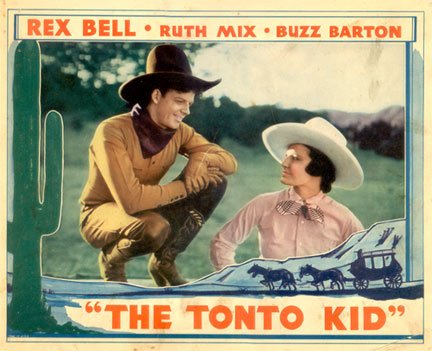
 “TONTO KID” (‘35 Resolute) “Three saddle aces add up to a full house” pronounced Resolute advertising. Rex Bell (off the screen for two years), Ruth Mix and Buzz Barton all start out on the devious side of the law but wind up on the right to outwit nefarious lawyer Ted Lorch. The first film for the new Resolute company was to be the first of six starrers for Bell/Mix/Barton, only four of which were actually made. Ruth Mix is Tom’s daughter, so Resolute was trading on her name. Buzz Barton had been a big star as a youngster in silents for FBO but never equaled that fame in talkies. “TONTO KID” (‘35 Resolute) “Three saddle aces add up to a full house” pronounced Resolute advertising. Rex Bell (off the screen for two years), Ruth Mix and Buzz Barton all start out on the devious side of the law but wind up on the right to outwit nefarious lawyer Ted Lorch. The first film for the new Resolute company was to be the first of six starrers for Bell/Mix/Barton, only four of which were actually made. Ruth Mix is Tom’s daughter, so Resolute was trading on her name. Buzz Barton had been a big star as a youngster in silents for FBO but never equaled that fame in talkies.
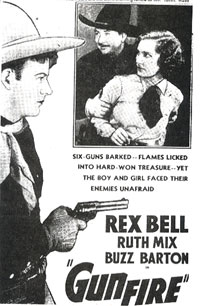  “GUNFIRE” (‘35 Resolute) Rex’s ranch partner Ruth Mix is in love with Rex. Ruth is jealous of Jane Irving, the abused stepdaughter of Lew Meehan, whom Bell has taken under his wing for protection at his ranch. Rex’s pal is out of work cowpoke Buzz Barton whom Bell also saves from meanie Meehan. (Watch for Barton’s startling backward somersault horse mount!) An unknown cowboy group sing on the range and do a couple more numbers at an extended barn dance sequence that interrupts the main story. The film is also marred by some very bad, laughable, barns-burning miniature work. “GUNFIRE” (‘35 Resolute) Rex’s ranch partner Ruth Mix is in love with Rex. Ruth is jealous of Jane Irving, the abused stepdaughter of Lew Meehan, whom Bell has taken under his wing for protection at his ranch. Rex’s pal is out of work cowpoke Buzz Barton whom Bell also saves from meanie Meehan. (Watch for Barton’s startling backward somersault horse mount!) An unknown cowboy group sing on the range and do a couple more numbers at an extended barn dance sequence that interrupts the main story. The film is also marred by some very bad, laughable, barns-burning miniature work.
 “FIGHTING PIONEERS” (‘35 Resolute) Boring, trite and sluggish. Not much to keep you awake as Cavalry Lieutenant Rex Bell discovers trader Stanley Blystone and supply sergeant Earl Dwire selling guns to the Indi-ans led by the late Chief’s daughter, Ruth Mix. Buzz Barton is wasted as Bell’s ebullient young orderly. “FIGHTING PIONEERS” (‘35 Resolute) Boring, trite and sluggish. Not much to keep you awake as Cavalry Lieutenant Rex Bell discovers trader Stanley Blystone and supply sergeant Earl Dwire selling guns to the Indi-ans led by the late Chief’s daughter, Ruth Mix. Buzz Barton is wasted as Bell’s ebullient young orderly.
 “SADDLE ACES” (‘35 Resolute) Only four of the six announced “trio” westerns starring Bell/Barton/Mix were made before the series—and Resolute itself—came to a quick abbreviated halt. “Saddle Aces” is the final of the four, very poorly slapped together by director Harry Fraser with a sub-par soundtrack. Fraser directed and wrote all four, often using his Harry Crist pseudonym. Bell and Barton are on a train bound for prison, unjustly framed for something or other. They escape and take refuge with Stanley Blystone’s rustlers who have discovered Ruth’s late father never registered his land. Blystone is after the deed, trading off Ruth to Mexican bandido El Conejo (Earl Dwire) in the process. Bell next signed with Colony. “SADDLE ACES” (‘35 Resolute) Only four of the six announced “trio” westerns starring Bell/Barton/Mix were made before the series—and Resolute itself—came to a quick abbreviated halt. “Saddle Aces” is the final of the four, very poorly slapped together by director Harry Fraser with a sub-par soundtrack. Fraser directed and wrote all four, often using his Harry Crist pseudonym. Bell and Barton are on a train bound for prison, unjustly framed for something or other. They escape and take refuge with Stanley Blystone’s rustlers who have discovered Ruth’s late father never registered his land. Blystone is after the deed, trading off Ruth to Mexican bandido El Conejo (Earl Dwire) in the process. Bell next signed with Colony.
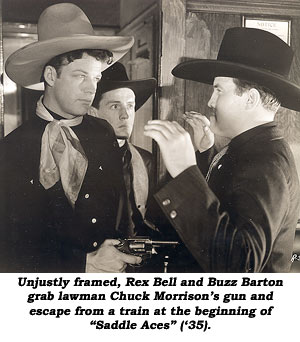
ZERO “TOO MUCH BEEF” (‘36 Colony) Too much plot and intrigue and way too little action and excitement. Convoluted story and motivations, as Cattlemen’s Association agent Bell investigates a rancher who turns up with too much beef framed by other crooked ranchers so they can sell some land to the railroad. No Bell-ringer here. The Alexander brothers formed Colony in ‘36 (after their Beacon Films folded in ‘35) to make six B-westerns with Bell.
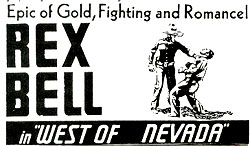  “WEST OF NEVADA” (‘36 Colony) Crooked banker Forrest Taylor and his gang will stop at nothing in their attempt to locate and claim the gold deposits on an Indian reservation which the Indians are mining with the help of Steve Clark and his daughter Joan Barclay. Taylor’s schemes are defeated by Bell and sidekick Al St. John, polishing his soon to be “Fuzzy” character. Boo Boo: Near the end, Rex Bell enters the mine, gun drawn, but in the next shot—interior of mine—his gun is holstered. “WEST OF NEVADA” (‘36 Colony) Crooked banker Forrest Taylor and his gang will stop at nothing in their attempt to locate and claim the gold deposits on an Indian reservation which the Indians are mining with the help of Steve Clark and his daughter Joan Barclay. Taylor’s schemes are defeated by Bell and sidekick Al St. John, polishing his soon to be “Fuzzy” character. Boo Boo: Near the end, Rex Bell enters the mine, gun drawn, but in the next shot—interior of mine—his gun is holstered.
 “IDAHO KID” (‘36 Colony) A good story well told has Bell, ousted by his father (Earl Dwire) after his wife’s death at childbirth, returning home in the middle of an escalating feud between his Dad and the man who raised him (Lafe McKee). Bell is also helping a young kid (Dave Sharpe) go straight. Marion Shilling is Lafe’s daughter and Charles King is Dwire’s trouble-stirring foreman. “IDAHO KID” (‘36 Colony) A good story well told has Bell, ousted by his father (Earl Dwire) after his wife’s death at childbirth, returning home in the middle of an escalating feud between his Dad and the man who raised him (Lafe McKee). Bell is also helping a young kid (Dave Sharpe) go straight. Marion Shilling is Lafe’s daughter and Charles King is Dwire’s trouble-stirring foreman.
 “MEN OF THE PLAINS” (‘36 Colony) Postal inspectors Bell and John Elliott are on the trail of train robbers. The case gets complicated when Bell encounters old girlfriend Joan Barclay now engaged to wimpy George Ball, one of the bandits tied in with suave Forrest Taylor and his gang. Routine stuff well handled by director Robert Hill and cameraman Robert Cline. “MEN OF THE PLAINS” (‘36 Colony) Postal inspectors Bell and John Elliott are on the trail of train robbers. The case gets complicated when Bell encounters old girlfriend Joan Barclay now engaged to wimpy George Ball, one of the bandits tied in with suave Forrest Taylor and his gang. Routine stuff well handled by director Robert Hill and cameraman Robert Cline.
 “STORMY TRAILS” (‘36 Colony) Convoluted plot has Bell and his sibling, Bob Hodges, plagued by a real estate speculator and a gang of cattle rustlers out to grab their ranch. Bank robbery, murder frames, night raids, stampedes, loan renewals and a gold mine all enter into the involved plot before Bell rounds up the crooks and Rex has his final clinch with pert little Lois Wilde (who needed more to do). The plot is confused but Bell handles the action well in his next to last series western. “STORMY TRAILS” (‘36 Colony) Convoluted plot has Bell and his sibling, Bob Hodges, plagued by a real estate speculator and a gang of cattle rustlers out to grab their ranch. Bank robbery, murder frames, night raids, stampedes, loan renewals and a gold mine all enter into the involved plot before Bell rounds up the crooks and Rex has his final clinch with pert little Lois Wilde (who needed more to do). The plot is confused but Bell handles the action well in his next to last series western.
 “LAW AND LEAD” (‘37 Colony) Cattle Association detective Rex Bell is after the Juarez Kid (Wally Wales). But finally getting him is barely worth the wait through subplots of disguises, dogs, notes, daughters, crooked card games and Mexican Senoras. Not Bell’s shining hour. Unbelievably loud truck noises on the inferior soundtrack in some places. The final starring western for Bell. “LAW AND LEAD” (‘37 Colony) Cattle Association detective Rex Bell is after the Juarez Kid (Wally Wales). But finally getting him is barely worth the wait through subplots of disguises, dogs, notes, daughters, crooked card games and Mexican Senoras. Not Bell’s shining hour. Unbelievably loud truck noises on the inferior soundtrack in some places. The final starring western for Bell.
 “DAWN ON THE GREAT DIVIDE” (‘42 Monogram) A lonesome affair, released about a month after Buck Jones’ tragic death in Boston’s Cocoanut Grove nightclub fire. A sad end to a stunning career, a plodding concern with the first 10 minutes or more given over to sluggishly introducing the characters on a wagon train of railroad supplies and new settlers. It’s a long first 30 minutes but scouts Buck Jones and Raymond Hatton finally arrive in Beaver Creek, where crooks have been raiding wagon trains disguised as Indians. Buck’s partner, Rex Bell, arrived earlier and worked his way into a position of confidence. A lot of plot and soap-operaish shenanigans confining the action to tepid when it finally arrives. “Dawn—” is a continuation of sorts of Jones and Hatton’s Rough Riders series with Rex Bell replacing Col. Tim McCoy who’d left the series to return to Armed Forces duty. If more were planned with this new trio, one could only hope they would have been more lively than this “Yawn On the Great Divide.” “DAWN ON THE GREAT DIVIDE” (‘42 Monogram) A lonesome affair, released about a month after Buck Jones’ tragic death in Boston’s Cocoanut Grove nightclub fire. A sad end to a stunning career, a plodding concern with the first 10 minutes or more given over to sluggishly introducing the characters on a wagon train of railroad supplies and new settlers. It’s a long first 30 minutes but scouts Buck Jones and Raymond Hatton finally arrive in Beaver Creek, where crooks have been raiding wagon trains disguised as Indians. Buck’s partner, Rex Bell, arrived earlier and worked his way into a position of confidence. A lot of plot and soap-operaish shenanigans confining the action to tepid when it finally arrives. “Dawn—” is a continuation of sorts of Jones and Hatton’s Rough Riders series with Rex Bell replacing Col. Tim McCoy who’d left the series to return to Armed Forces duty. If more were planned with this new trio, one could only hope they would have been more lively than this “Yawn On the Great Divide.”
Rex had married the “It” girl, Clara Bow, in ‘31 and was spending more time with her on their ranch outside Searchlight, NV. Rex opened a western wear store in Las Vegas, lost a Republican bid for Congress in ‘44 but was elected Lt. Gov. of Nevada from ‘54-‘62. He did manage to co-star with Buck Jones in “Dawn on the Great Divide” in ‘42 and play small roles in “Tombstone, the Town too Tough to Die” (‘42) and two Clark Gable films, “Lone Star” (‘52) and “The Misfits” (‘61).
At 58, Bell died of a heart attack on July 4, 1962, two weeks after filing his candidacy for governor. Clara died in ‘65.
|

